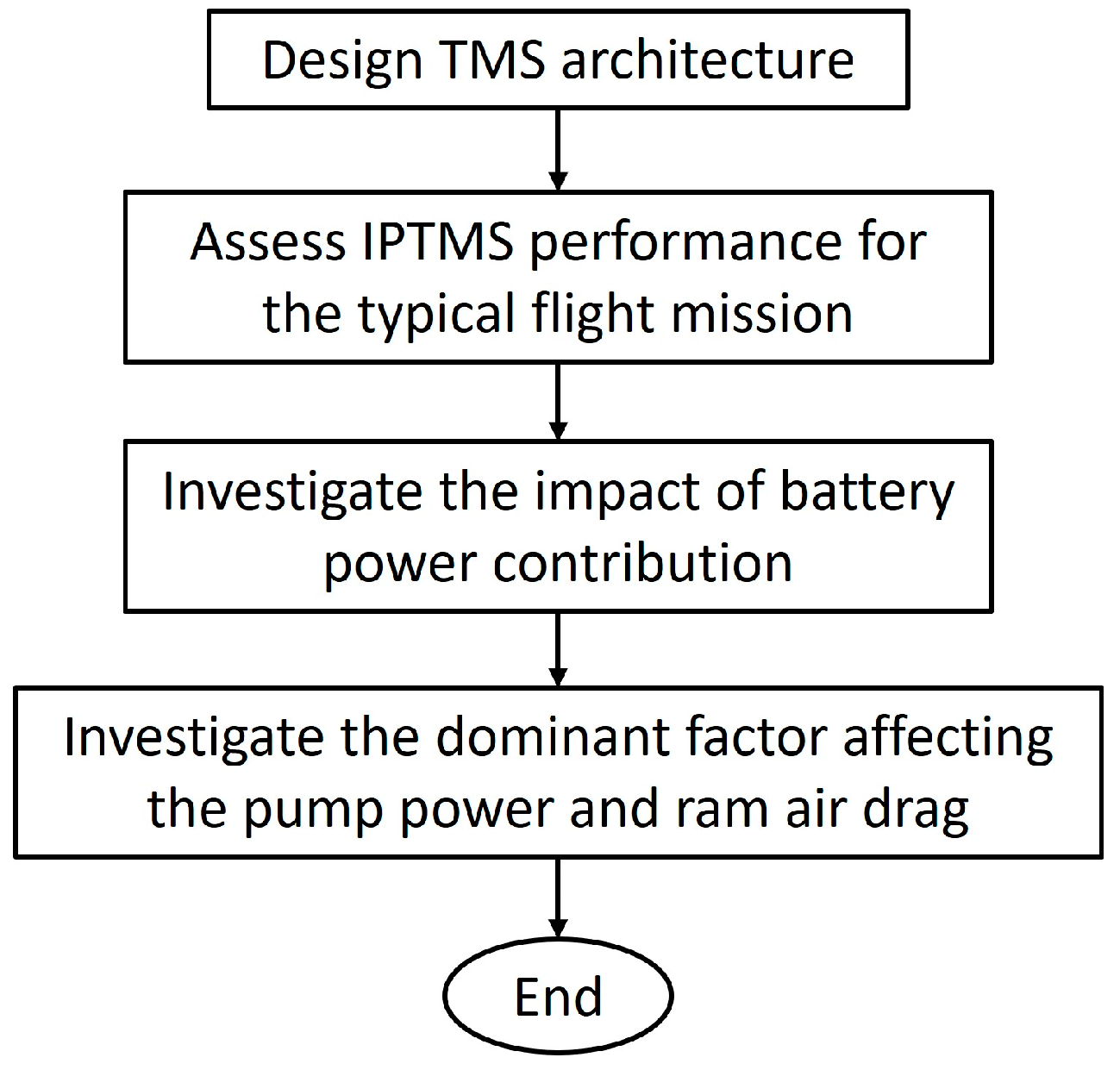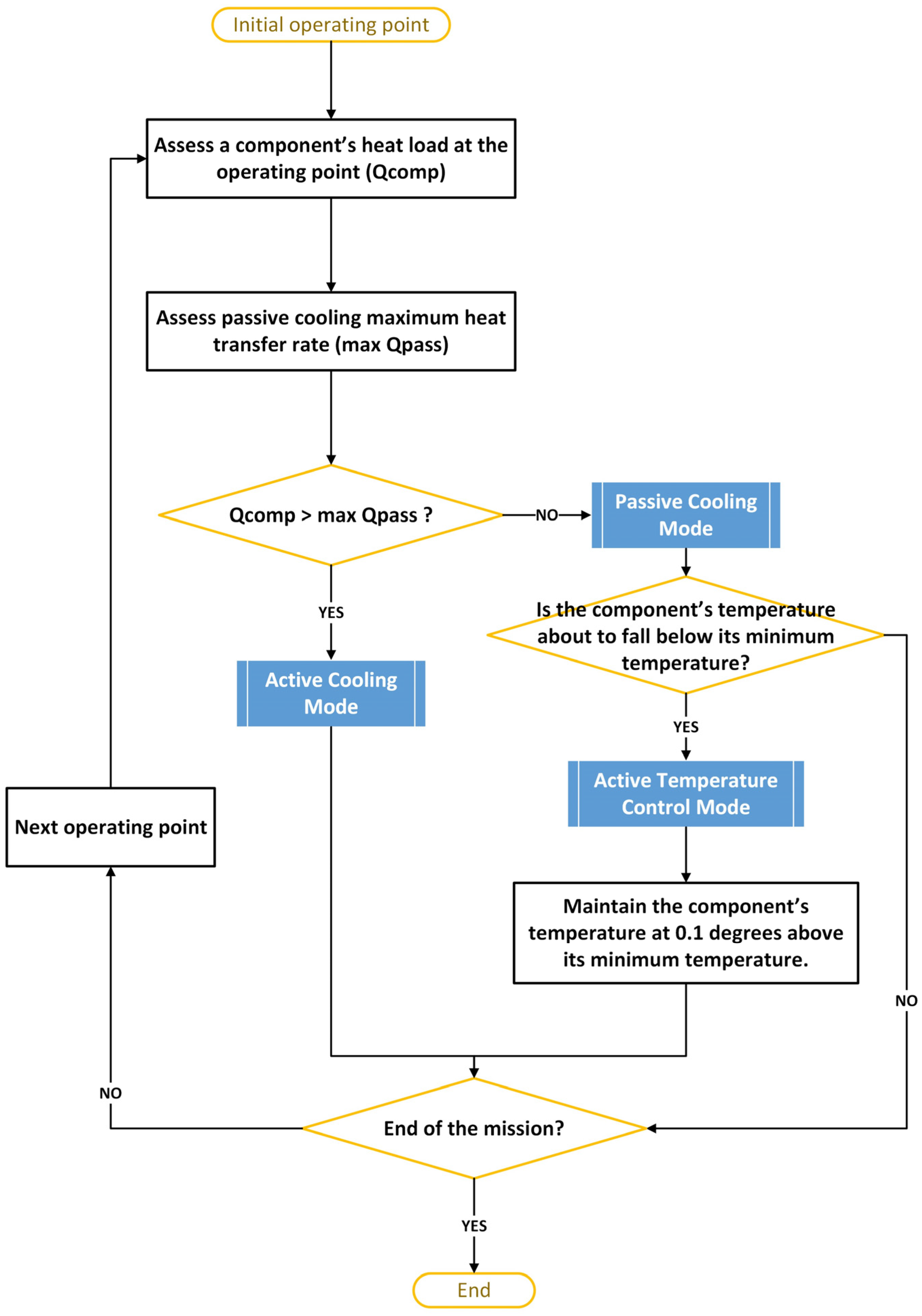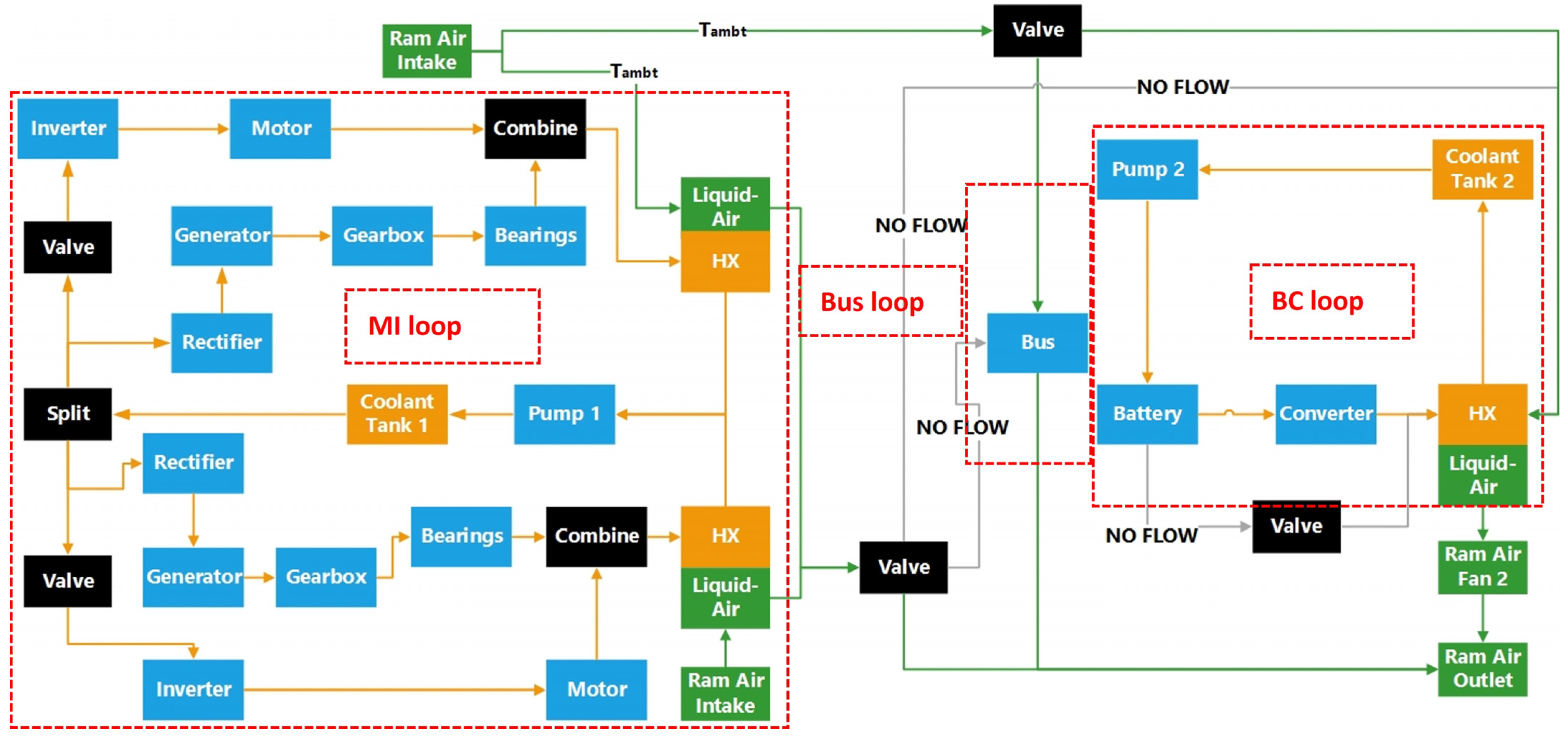Integrated Power and Thermal Management System in a Parallel Hybrid-Electric Aircraft: An Exploration of Passive and Active Cooling and Temperature Control †
Abstract
1. Introduction
- Which domain offers more potential for the IPTMS optimization: thermal management or power management?
- What are the dominant factors affecting power usage and induced drag of the TMS?
2. Methodology of the IPTMS Preliminary Design
3. Proposed Study
4. Results Analysis
- Optimize the MI loop cooling strategy, such as using phase-change cooling or other efficient cooling strategies.
- Split the MI loop into two loops, cooling the motors and inverters in one loop and the gas turbine engine system components in the other loop.
- Select another coolant with higher thermal conductivity for cooling the motors and the inverters.
5. Conclusions and Future Work
- The magnitude of battery power contribution to cooling power does not significantly impact thermal management system (TMS) performance due to the large difference between the total battery power (maximum 950 kW) and the required cooling power (maximum 443 W).
- The battery can fully support cooling power, helping to reduce fuel consumption, while maintaining 20% state of charge at the top of the climb.
- The motor-inverter loop is the primary driver of TMS performance, accounting for 97% of pump power and 98% of induced drag.
Author Contributions
Funding
Institutional Review Board Statement
Informed Consent Statement
Data Availability Statement
Conflicts of Interest
References
- ACARE. Fly the Green Deal—Europe‘s Vision for Sustainable Aviation; Publications Office of the European Union: Luxemburg, 2022. [Google Scholar]
- NASA. Strategic Implementation Plan 2017 Update; NASA: Washington, DC, USA, 2017.
- Rheaume, J.M.; Lents, C.E. Commercial Hybrid Electric Aircraft Thermal Management Sensitivity Studies. In Proceedings of the AIAA Propulsion and Energy 2020 Forum, New Orleans, LA, USA, 26–28 August 2020; American Institute of Aeronautics and Astronautics: Reston, VA, USA, 2020; pp. 1–6. [Google Scholar]
- Roberts, R.; Eastbourn, S. Vehicle Level Tip-to-Tail Modeling of an Aircraft. Int. J. Thermodyn. 2014, 17, 107–115. [Google Scholar] [CrossRef]
- Ganev, E.; Koerner, M. Power and Thermal Management for Future Aircraft. In Proceedings of the SAE 2013 Aerotech Congress and Exhibition, Montreal, QC, Canada, 24–26 September 2013. [Google Scholar]
- Aerospace Technology Institute. Accelerating Ambition Foreword Overview of Priorities Air Transport Vision Market Opportunity Vehicles Propulsion and Power Systems Aerostructures Cross-Cutting Enablers Economic Impact Closing Remarks; Aerospace Technology Institute: Cranfield, UK, 2019. [Google Scholar]
- Misley, A.A.; D’Arpino, M.; Ramesh, P.; Canova, M. A Real-Time Energy Management Strategy for Hybrid Electric Aircraft Propulsion Systems. In Proceedings of the AIAA Propulsion and Energy 2021 Forum, Denver, CO, USA, 11–13 August 2021; American Institute of Aeronautics and Astronautics: Reston, VA, USA, 2021. [Google Scholar]
- Kellermann, H.; Lüdemann, M.; Pohl, M.; Hornung, M. Design and Optimization of Ram Air–Based Thermal Management Systems for Hybrid-Electric Aircraft. Aerospace 2020, 8, 3. [Google Scholar] [CrossRef]
- Zhao, C.; Clarke, M.; Kellermann, H.; Verstraete, D. Liquid Cooling Systems for Batteries of Electric Vertical Takeoff and Landing Aircraft. J. Aircr. 2024, 61, 667–683. [Google Scholar] [CrossRef]
- Shi, M.; Sanders, M.; Alahmad, A.; Perullo, C.; Cinar, G.; Mavris, D.N. Design and Analysis of the Thermal Management System of a Hybrid Turboelectric Regional Jet for the NASA ULI Program. In Proceedings of the AIAA Propulsion and Energy 2020 Forum, New Orleans, LA, USA, 26–28 August 2020; American Institute of Aeronautics and Astronautics: Reston, VA, USA, 2020; pp. 1–24. [Google Scholar]
- Adler, E.J.; Brelje, B.J.; Martins, J.R.R.A. Thermal Management System Optimization for a Parallel Hybrid Aircraft Considering Mission Fuel Burn. Aerospace 2022, 9, 243. [Google Scholar] [CrossRef]
- Kim, J.H.; Kwon, K.S.; Roy, S.; Garcia, E.; Mavris, D. Megawatt-Class Turboelectric Distributed Propulsion, Power, and Thermal Systems for Aircraft. In Proceedings of the 2018 AIAA Aerospace Sciences Meeting, Kissimmee, FL, USA, 8–12 January 2018. [Google Scholar]
- Rheaume, J.M.; MacDonald, M.; Lents, C.E. Commercial Hybrid Electric Aircraft Thermal Management System Design, Simulation, and Operation Improvements. In Proceedings of the AIAA Propulsion and Energy 2019 Forum, Indianapolis, IN, USA, 22–24 August 2019; American Institute of Aeronautics and Astronautics: Reston, VA, USA, 2019. [Google Scholar]
- Schnulo, S.L.; Chapman, J.W.; Hanlon, P.; Hasseeb, H.; Jansen, R.; Sadey, D.; Sozer, E.; Jensen, J.; Maldonado, D.; Bhamidapati, K.; et al. Assessment of the Impact of an Advanced Power System on a Turboelectric Single-Aisle Concept Aircraft. In Proceedings of the AIAA Propulsion and Energy 2020 Forum, New Orleans, LA, USA, 26–28 August 2020; American Institute of Aeronautics and Astronautics: Reston, VA, USA, 2020; pp. 1–18. [Google Scholar]
- Heersema, N.; Jansen, R. Thermal Management System Trade Study for SUSAN Electrofan Aircraft. In Proceedings of the AIAA SCITECH 2022 Forum, San Diego, CA, USA, 3–7 January 2022; American Institute of Aeronautics and Astronautics: Reston, VA, USA, 2022. [Google Scholar]
- Coutinho, M.; Afonso, F.; Souza, A.; Bento, D.; Gandolfi, R.; Barbosa, F.R.; Lau, F.; Suleman, A. A Study on Thermal Management Systems for Hybrid–Electric Aircraft. Aerospace 2023, 10, 745. [Google Scholar] [CrossRef]
- Nyamagoudar, V.; P R, N.; Balasubrahmanyam, M.; Vanka, S.; Gattu, R.; Abuheiba, A.; Jha, R.K. Hybrid Cooling System for Thermal Management in Electric Aerial Vehicles; SAE Technical Paper 2024-26-0468; SAE International: Warrendale, PA, USA, 2024. [Google Scholar] [CrossRef]
- Ouyang, Z.; Nikolaidis, T.; Jafari, S. Integrated Power and Thermal Management System for A Hybrid-Electric Aircraft: Integrated Modeling and Passive Cooling Analysis. J. Eng. Gas. Turbine Power 2024, 146, 111024. [Google Scholar] [CrossRef]
- Rheaume, J.; Lents, C.E. Design and Simulation of a Commercial Hybrid Electric Aircraft Thermal Management System. In Proceedings of the 2018 AIAA/IEEE Electric Aircraft Technologies Symposium, Cincinnati, OH, USA, 12–14 July 2018; American Institute of Aeronautics and Astronautics: Reston, VA, USA, 2018. [Google Scholar]
- Chapman, J.W.; Schnulo, S.L.; Nitzsche, M.P. Development of a Thermal Management System for Electrified Aircraft. In Proceedings of the AIAA SCITECH 2020 Forum, Orlando, FL, USA, 6–10 January 2020; American Institute of Aeronautics and Astronautics: Reston, VA, USA, 2020. [Google Scholar]





| Component | Tmin (°C) | Tmax (°C) |
|---|---|---|
| Motor | −20 | 220 |
| Inverter | −20 | 150 |
| Bus | −20 | 70 |
| Converter | −20 | 150 |
| Battery | 15 | 45 |
Disclaimer/Publisher’s Note: The statements, opinions and data contained in all publications are solely those of the individual author(s) and contributor(s) and not of MDPI and/or the editor(s). MDPI and/or the editor(s) disclaim responsibility for any injury to people or property resulting from any ideas, methods, instructions or products referred to in the content. |
© 2025 by the authors. Licensee MDPI, Basel, Switzerland. This article is an open access article distributed under the terms and conditions of the Creative Commons Attribution (CC BY) license (https://creativecommons.org/licenses/by/4.0/).
Share and Cite
Ouyang, Z.; Nikolaidis, T.; Jafari, S.; Pontika, E. Integrated Power and Thermal Management System in a Parallel Hybrid-Electric Aircraft: An Exploration of Passive and Active Cooling and Temperature Control. Eng. Proc. 2025, 90, 36. https://doi.org/10.3390/engproc2025090036
Ouyang Z, Nikolaidis T, Jafari S, Pontika E. Integrated Power and Thermal Management System in a Parallel Hybrid-Electric Aircraft: An Exploration of Passive and Active Cooling and Temperature Control. Engineering Proceedings. 2025; 90(1):36. https://doi.org/10.3390/engproc2025090036
Chicago/Turabian StyleOuyang, Zeyu, Theoklis Nikolaidis, Soheil Jafari, and Evangelia Pontika. 2025. "Integrated Power and Thermal Management System in a Parallel Hybrid-Electric Aircraft: An Exploration of Passive and Active Cooling and Temperature Control" Engineering Proceedings 90, no. 1: 36. https://doi.org/10.3390/engproc2025090036
APA StyleOuyang, Z., Nikolaidis, T., Jafari, S., & Pontika, E. (2025). Integrated Power and Thermal Management System in a Parallel Hybrid-Electric Aircraft: An Exploration of Passive and Active Cooling and Temperature Control. Engineering Proceedings, 90(1), 36. https://doi.org/10.3390/engproc2025090036









